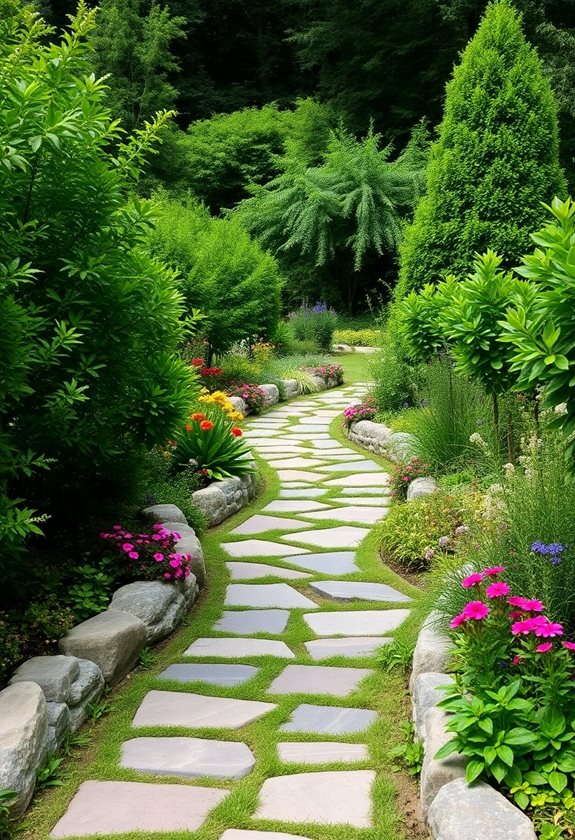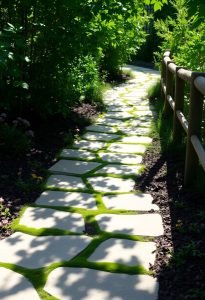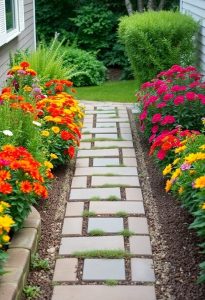Wanna blend your garden paths with existing plantings? Start by evaluating your layout and sketching potential path designs! Choose materials that vibe with your garden’s style, like durable stone or fun gravel. Keep paths at least three feet wide, and opt for gentle curves—they’re inviting! Integrate colorful plants and decorative features to add charm. Don’t forget seasonal blooms and cozy benches! Excited to make your garden flow? There’s so much more to explore!
Design Highlights
- Use a garden hose to outline curves that mimic the natural flow of existing plantings for a harmonious look.
- Choose path materials that complement the colors and textures of nearby plants for a cohesive design.
- Incorporate low-growing plants along the edges of paths to maintain visibility and enhance the overall aesthetic.
- Add decorative features like whimsical birdhouses or colorful stakes that reflect the garden’s style and engage visitors.
- Regularly update seasonal blooms in planters along the path to ensure visual interest throughout the year.
Assess Your Garden Layout
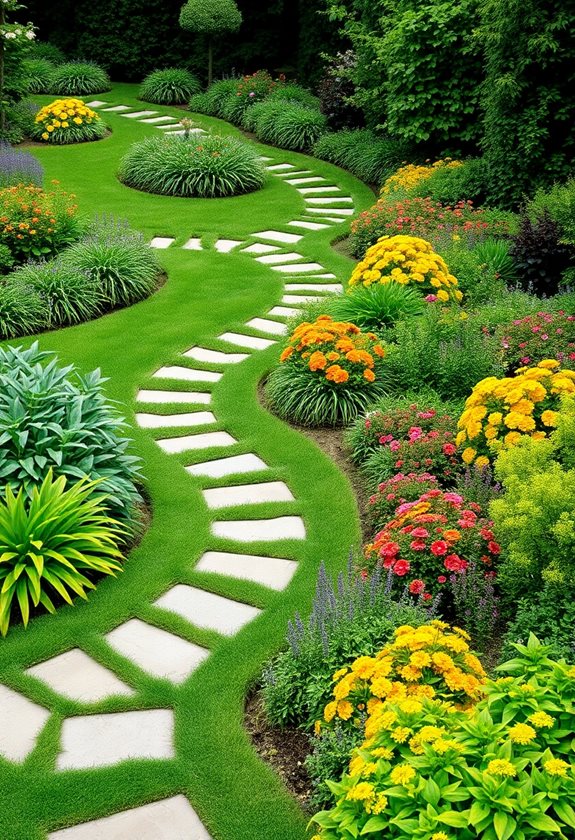
When you step into your garden, do you see a blank canvas waiting for your creative touch, or is it more like a jigsaw puzzle with a few missing pieces? Evaluating your garden layout is essential for creating a harmonious space. Start by observing sunlight patterns and existing structures. Are there areas that feel cramped? Could some plants use more room to breathe? Sketch your layout, marking where paths could lead. Remember, every curve and turn can invite exploration! To make it fun, think about how your garden can evolve. You might stumble upon the perfect spot for that whimsical statue! Additionally, consider how the choice of material durability will impact the overall design and longevity of your pathways.
Choose the Right Materials
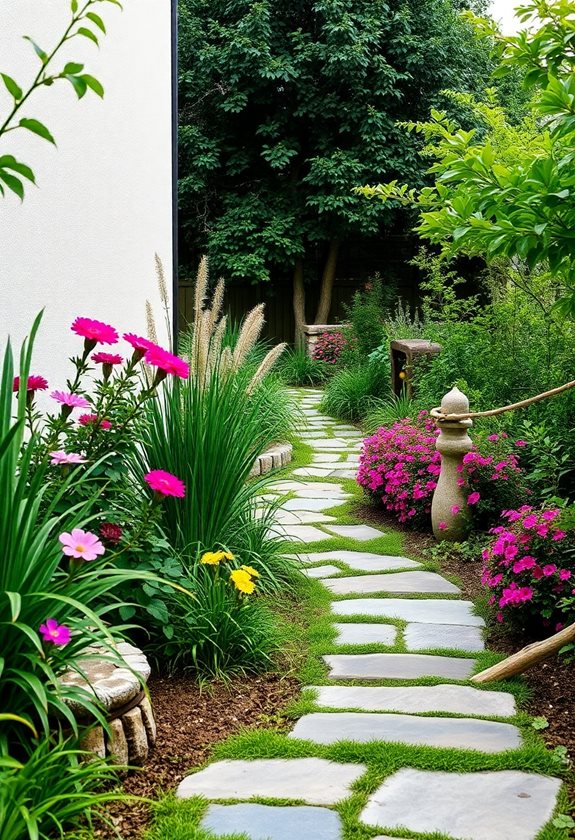
After mapping out your garden layout, it’s time to think about the materials you’ll use to bring your vision to life. Choosing the right materials can elevate your path and harmonize with your existing plantings. Do you envision rustic charm or sleek modernity? Here are some options:
- Stone: Durable and timeless.
- Gravel: Easy to install and excellent for drainage.
- Pavers: Versatile and customizable.
Consider how each material complements your garden’s style. Remember, it’s not just about function; it’s about creating an inviting atmosphere. Weather-resistant materials ensure longevity, so choose wisely. What story do you want your garden path to tell? Let your creativity flow!
Consider Path Width and Shape

As you plunge into designing your garden path, it’s essential to think about the width and shape—after all, a well-planned path can make your garden feel more inviting and accessible. Here are a few tips to guide you:
- Width: Aim for at least 3 feet to allow comfortable passage.
- Shape: Consider straight lines for formality or curves for a relaxed feel.
- Functionality: Verify the path accommodates wheelbarrows or garden carts.
- Aesthetics: Match the path shape with existing plantings for a harmonious look. Additionally, using quality pathway materials can enhance both durability and visual appeal, ensuring your garden paths remain attractive over time.
Create Natural Curves
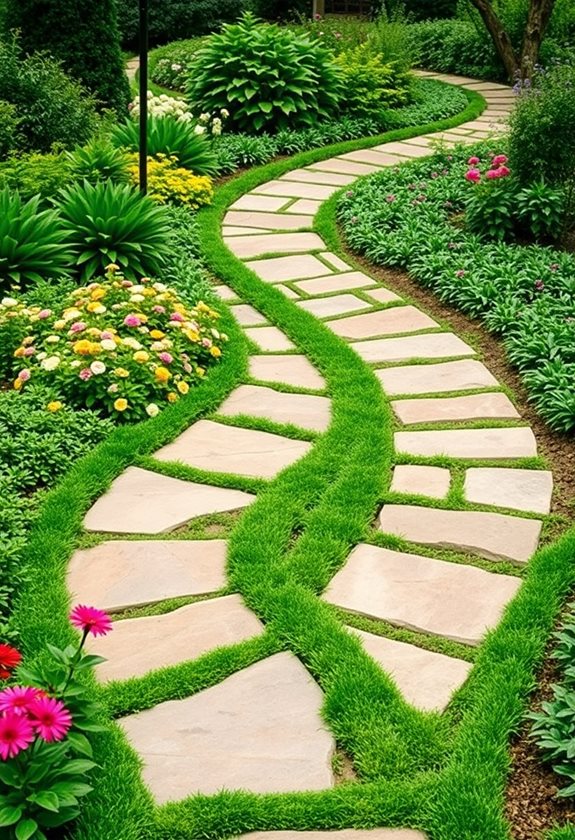
Creating natural curves in your garden path can transform an ordinary layout into something truly enchanting. Imagine walking along a path that gently winds, inviting exploration. To achieve this, start by envisioning the flow of your garden.
Transform your garden with gentle, winding paths that invite exploration and enchantment. Embrace curves for a magical outdoor experience!
- Use a garden hose to outline curves.
- Adjust until it feels organic and harmonious.
- Remember, sharp angles can feel jarring!
Curves encourage curiosity—don’t you want visitors to discover what lies beyond? When I first curved my path, I felt like a kid again, wandering into a secret garden. So, embrace those bends; they’ll breathe life into your outdoor space! Adding beautiful winding paths can further enhance the charm of your garden.
Integrate Plantings Along the Path
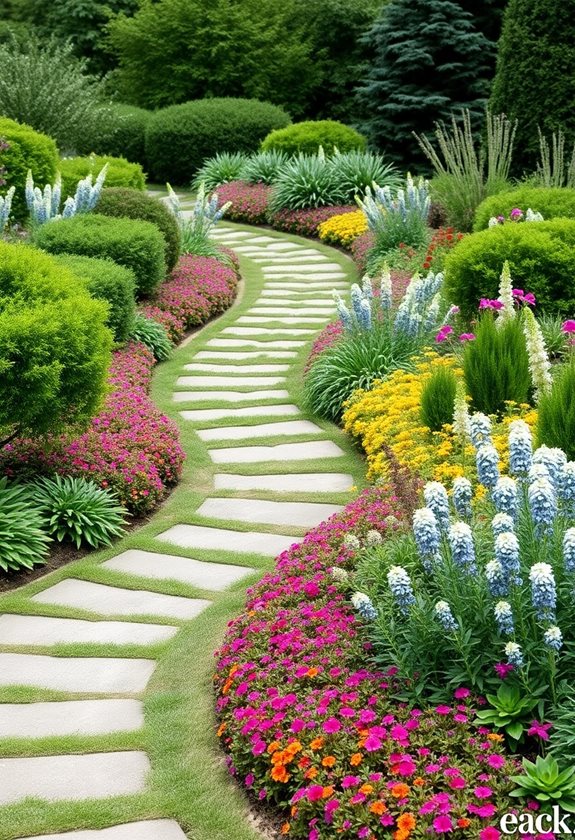
While you might think of your garden path as just a way to get from point A to point B, integrating plantings along the sides can really elevate the whole experience! Imagine lush greenery and colorful blooms framing your pathway—it’s like a warm hug for your garden! Here are some tips to get you started:
- Choose low-growing plants to avoid obstructing views.
- Use perennials for year-round interest and easy maintenance.
- Incorporate fragrant herbs for sensory delight as you stroll.
- Add seasonal flowers for vibrant pops of color.
Additionally, consider using natural materials for your path to create a seamless transition between the garden aesthetics and your pathways.
Use Color and Texture to Complement

Color and texture can transform a garden path from ordinary to extraordinary! Imagine stepping onto a path that complements your lush greenery. To achieve this, consider the following:
- Choose colors that echo your existing plants. If you’ve vibrant flowers, opt for path materials in subtle, earthy tones.
- Mix textures—smooth stones paired with rougher bricks can create visual interest.
- Incorporate seasonal plants that bloom in harmony with your path’s hues. Additionally, consider adding a garden waterfall feature nearby to enhance the serene atmosphere of your outdoor space.
Incorporate Edging Elements
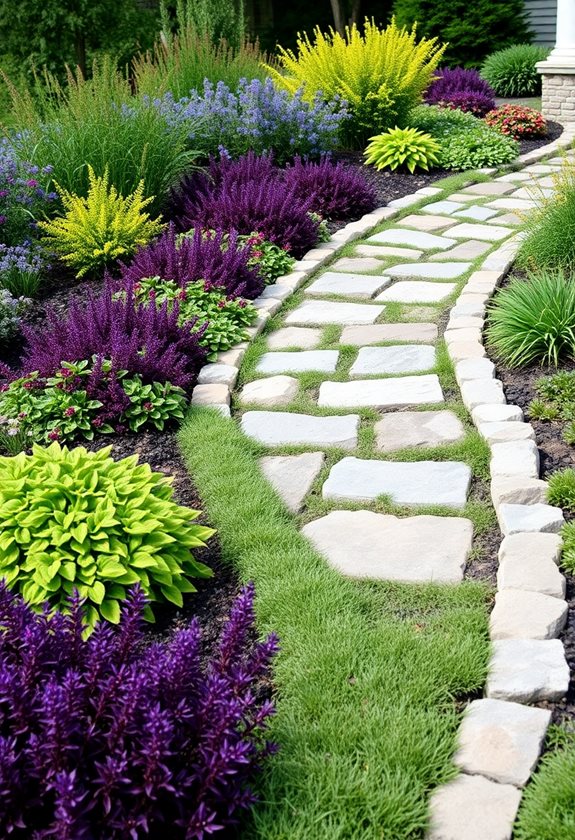
Edging elements can make all the difference in defining your garden path, especially when they frame your beautiful blooms and greenery. They not only enhance visual appeal but also keep soil and mulch in place. Here are some great options to contemplate:
- Brick or Stone: Timeless and sturdy, they bring a classic charm.
- Wooden Borders: Perfect for a rustic touch, but treat them for longevity!
- Metal Edging: Sleek and modern, they create clean lines.
- Living Edges: Use low-growing plants like thyme for a natural look!
Incorporating eco-friendly fencing solutions can also help to define your garden space sustainably. Which one will you choose to elevate your garden path? Happy gardening!
Plan for Seasonal Changes
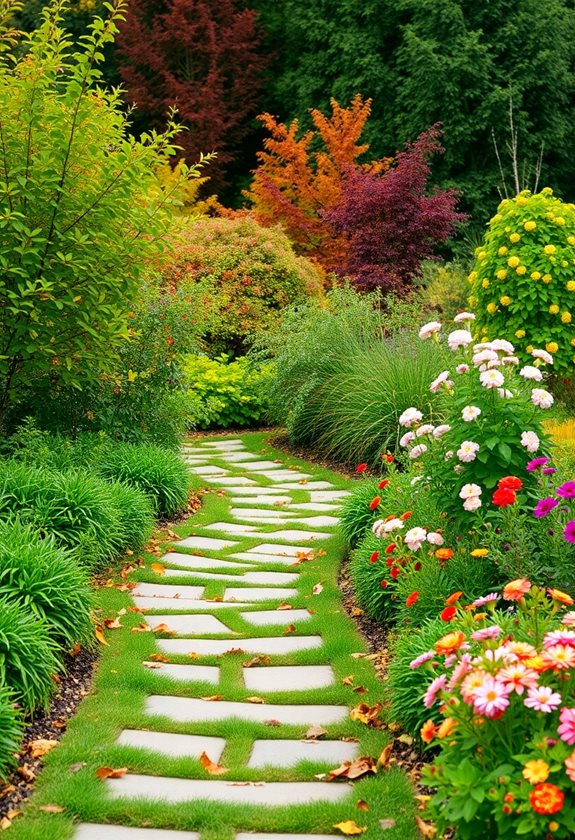
Gardening is a year-round adventure, and planning for seasonal changes can make your garden path not just beautiful, but also functional no matter the time of year! Think about how your plants transform with each season. In spring, vibrant blooms can frame your path, while summer’s lush foliage creates a cozy walkway. As autumn arrives, consider adding colorful leaves or decorative stones for texture. Winter? Well, evergreen plants or a touch of holiday decor can keep things lively! By anticipating these shifts, you’ll guarantee your path remains a stunning focal point, no matter the season. Isn’t that the dream? Additionally, incorporating stunning planting schemes can enhance the overall appeal and harmony of your garden borders throughout the year.
Maintain Accessibility and Flow
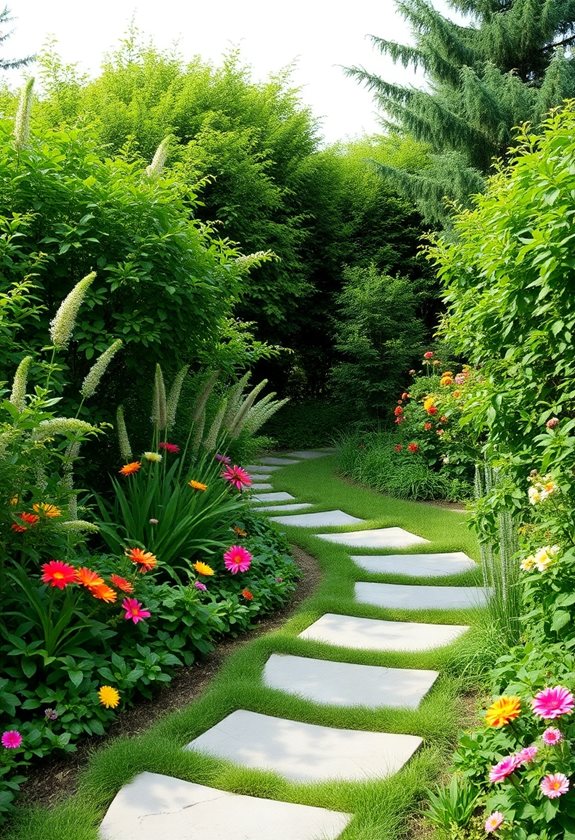
While you’re dreaming up the perfect garden path, don’t forget about accessibility and flow! You want your guests to glide through your garden, not feel like they’re maneuvering a maze. Here are four tips to keep things smooth:
Dreaming of a garden path? Prioritize accessibility and flow for a welcoming experience!
- Choose the Right Material: Make certain it’s easy to walk on, like gravel or pavers.
- Consider Width: At least three feet wide allows two people to pass comfortably.
- Keep It Clear: Trim back overgrown plants to maintain sightlines.
- Plan for Curves: Gentle bends invite exploration and soften the path’s appearance.
Additionally, incorporating beautiful pathway solutions can enhance the overall aesthetic of your garden. Your garden should feel welcoming!
Add Decorative Features for Interest
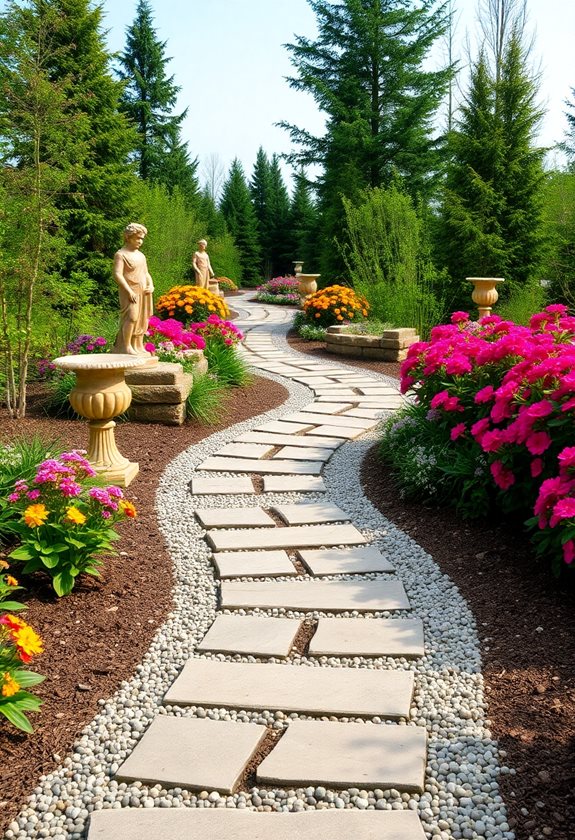
As you envision your garden path, why not sprinkle in some decorative features that add character and charm? Think of whimsical birdhouses, colorful garden stakes, or even a charming bench to rest on. You could incorporate:
- Stepping stones with unique designs.
- Solar lights to illuminate the path at night.
- Planters brimming with seasonal blooms.
Each touch enhances your path’s allure, drawing visitors in. Remember, it’s about creating an inviting atmosphere. What’s your favorite garden accent? A well-placed feature can transform your space from ordinary to extraordinary—just like adding sprinkles to a cupcake! To enhance the beauty of your garden path, consider using unique stepping stones that reflect your personal style. Happy decorating!
Frequently Asked Questions
How Do I Choose Plants That Won’T Obstruct the Path?
Choosing plants that won’t obstruct your path can be tricky, but it’s totally doable! Start by considering low-growing varieties like creeping thyme or dwarf marigolds. They’re beautiful, won’t block your way, and add a splash of color! Also, think about the width of your path — narrow paths need smaller plants. Have you ever tripped over a big bush? Avoid that! Remember, you want your garden to be a joy, not an obstacle course!
What Are the Best Materials for a Budget-Friendly Garden Path?
You know what they say, “A penny saved is a penny earned!” For a budget-friendly garden path, consider materials like mulch, gravel, or reclaimed bricks. They’re not only easy on the wallet, but they also provide a natural look! Just think about how those pebbles will crunch underfoot. You can even mix and match for a unique design. So, what are you waiting for? Let your creativity bloom! 🌼
How Can I Make a Narrow Path Feel Wider?
To make a narrow path feel wider, you can use a few clever tricks! First, try painting the edges in a lighter color—this visually expands the space. You could also line the path with tall plants or garden art to draw the eye upward, creating an illusion of height. Finally, consider using larger stones or pavers. Who knew a little creativity could stretch your garden’s personality? Get ready to impress your friends!
Should I Prioritize Functionality or Aesthetics When Designing My Path?
When designing your path, you can’t underestimate the power of balance—it’s like creating a masterpiece! Prioritize functionality first; a path should guide you through your garden like a trusty friend. Once that’s set, sprinkle in some aesthetics to make it visually stunning! Think about materials, colors, and surrounding plants. Ask yourself: Does it invite you to explore? Remember, it’s your garden, so let your personality shine through every step!
How Do I Prevent Weeds From Growing Alongside the Path?
To prevent weeds from sneaking alongside your path, you’ve got a few solid strategies! First, consider laying down landscape fabric before adding gravel or mulch—this blocks sunlight and stifles those pesky weeds. Next, keep your path edges trimmed and tidy; regular maintenance can make a world of difference. And don’t forget to use a good layer of mulch—it’s like a cozy blanket for your plants, while keeping weeds at bay! Excited to try this?

